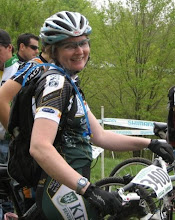The weather is crisp - well, and raining here. Are you ready for the season? I'm already doing a bunch of the physical fitness parts of early season success. But in addition to raking leaves, there's some homebound tasks I need to complete before my season starts on December 1st at training. Guess I'd better get these done during the dark days of November.
My to do list:
- Find my boots in the basement. They are somewhere behind the bike wheels, spare tires, rags, boxes of powdered drink mixes and camping gear. somewhere.
- Try them on and call my bootfitter if I need to. It's always easier to get work done in November than the week before Christmas.
- Find some skis, get the bindings set, wax 'em, tune them. We left our skis in pretty good shape after our late Spring Utah trip last year, but I also picked up a new pair and we have a bit of switching around to do.
- Find poles. Seems these are easy to forget the first trip of the season.
- Dig out all the clothes, wash with TechWash, order new mittens and any layers I anticipate needing. Particularly important this year because I lost some weight. I know many of my pants don't fit. Hopefully the ones I bought in the spring on SteepAndCheap.com will!
- Touch base with our mountain's training and ski school directors. I have some goals for the season. If I let them in on it, often they can help me by providing assignments that further my goals.
- Email our PSIA-E dev. team coach. See #6. I'll ski with Matt at our upcoming training anyway, but always good to start the conversation early and let him mull things over.
- Reconnect with a few people I met out on the road last year who were looking for specific guidance this year in their ski teaching and training.
- Catch up on my PSIA SnowPro and 32 Degrees reading. And tech manual review. And start looking at some video while I'm on the stationary bike in the basement.
- Review last year's notes from trainings, understudies, and clinics I led at the home mountain. In truth, I've already done some of this and am starting to brainstorm how I can improve my teaching. I was out on the road bike the other day thinking about how to get new instructors to coach movements more effectively and, in particular, how to demonstrate to them in a concrete way the differences between instruction and coaching.
- Flip through the latest toy guide and read a couple game reviews. Yeah, I don't have kids. But I get to teach them and I'm not exactly in the same movie demographic as they are. Can't really expect a 6 year old to connect with me over the latest chick flick.
- Wait. I'm really not a patient person.
Hope to see y'inz in a month or so!

Comments
Post a Comment